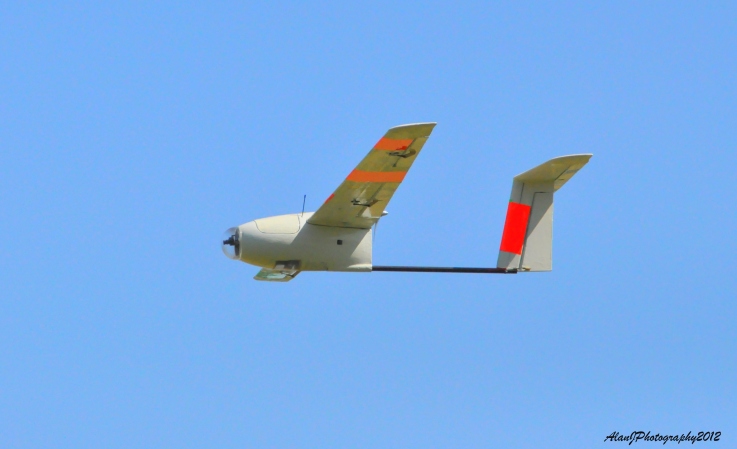
The Picture above is of my FlameWheel 450 with one added propeller motor Unit. It is for testing the feasibility and potential value of providing 4 opposed motor propeller units for providing position control instead of copter pitch and tilt. For testing purposes the horizontal motor / ESC is controlled manually from a separate receiver channel controlled by an analog "dial" on the transmitter.
Oliver Seeler and I are both pursuing the possibility of providing a more stable multicopter platform by separating the stability control of the copter from tilt and pitch based position control. Oliver is using a Hex Flamewheel with a setup very similar to the above at the moment.
This Blog is an outgrowth of a Forum item started by Oliver under "Aircraft platforms" entitled "The Witch Gets a Broom".
First test flights are complete on both of these copters and some significant data has been learned.
On Oliver's Hex considerable thrust was required to move the copter horizontally even at a slow pace. On my copter a very small horizontal thrust (< 1/3 throttle) moved the copter smoothly at a slow walking pace and my Quad's motor thrust is tiny in comparison with Oliver's Hex.
Oliver's Hexacopter's center of gravity is considerably lower than mine due to tall landing gear, a camera mount and GoPro camera but his horizontal motor and prop unit are mounted in the same location as mine. This means that the horizontal props center of thrust is considerably further above Olvier's Hexacopters CG than is true for my Quad.
From this result we have concluded that it is very important to have the horizontal thrust line aligned closely to the copters center of gravity. Failure to do so induces tilt which the stability mode of the APM counters by applying opposing vertical thrust, doing a surprisingly good job of cancelling out the horizontal thrust. My copter as seen above does not have this problem and requires very little power to smoothly produce horizontal flight.
Also, Oliver's Hex has the prop mounted in a pusher mode and on my Quad it is mounted in tractor (puller) mode. It appears either mode can be made to work satisfactorily. I was concerned that mine in tractor mode would have the horizontal prop wash interfering with the copters downward prop wash and might induce instability. At the power levels tried so far, no negative effect is observable and transition to and from horizontal flight is very smooth and without tilt.
My conclusion from the results achieved so far is that using a horizontal propeller for position control actually does make more stable flight possible with little or no pitch or roll of the airframe. I will continue to test in this configuration at higher power settings to insure stability is not significantly degraded.
But I am also beginning work on a setup that will place prop motor units between each of a Quads 4 vertical thrust rotors.
The intention of this configuration 4 x 4 is that the 4 horizontal motors will completely take over horizontal position control.
The existing APM programming and the Vertical thrust motors will be responsible for stabilization, altitude control and the yaw or horizontal orientation of the air frame. This way only balanced symmetrical vertical thrust on the air frame is required to adjust altitude and yaw and the only asymmetrical thrust is in direct response to outside forces trying to pitch or tilt the air frame. Basically it's entire vertical thrust resources are used keeping it level and there is no purposely induced tilt or pitch as is conventionally necessary for position control.
Control for the 4 x 4 unit will necessarily be more involved as it will be desirable at a minimum to produce differential control of all 4 props using a stick. This means that zero thrust of all 4 motors would be at "stick center" position and pushing in any direction would produce differential activation on one or 2 motors in that direction producing a horizontal displacement similar to what is done now with a quad copter using the APM.
This is not achievable from a transmitter directly and requires at least translation of stick center to = zero throttle on all four motors.
My initial solution to this will to be to either use an auxiliary (in addition to the APM) Arduino processor to take normal stick input servo data and translate it to the controls for the 4 motors or I may attempt to simply incorporate the control into the APM if my programming capabilities and available resources prove adequate to the task.
The hardware part is easy, the programming part, less so.
Oliver and I very much welcome and would like to solicit your comments, thoughts and contributions on this project, and if somebody with more APM programming experience than I would like to jump in there, please feel free.
Keep in mind, the silly thing in the picture actually works and there is no perceptible air frame tilt or pitch when you use the horizontal motor to move it.

This is a new kind of aircraft which so far appears to be feasible and also that it might have some really significant advantages and capabilities.

Current Design Above.


